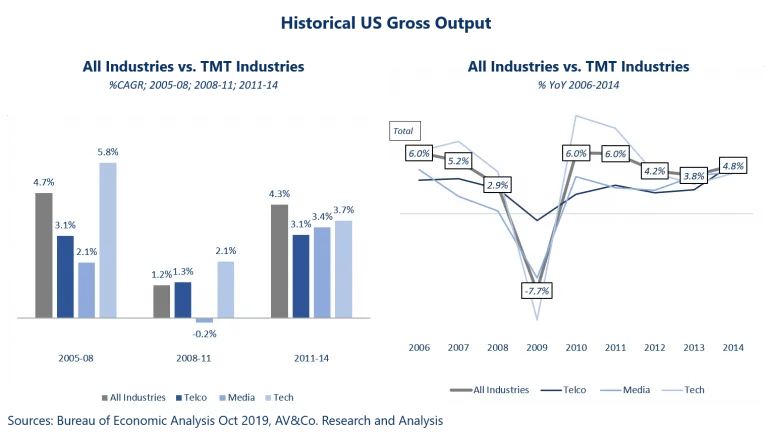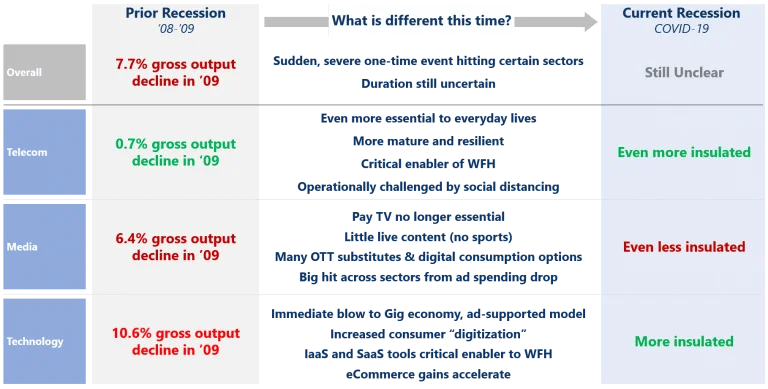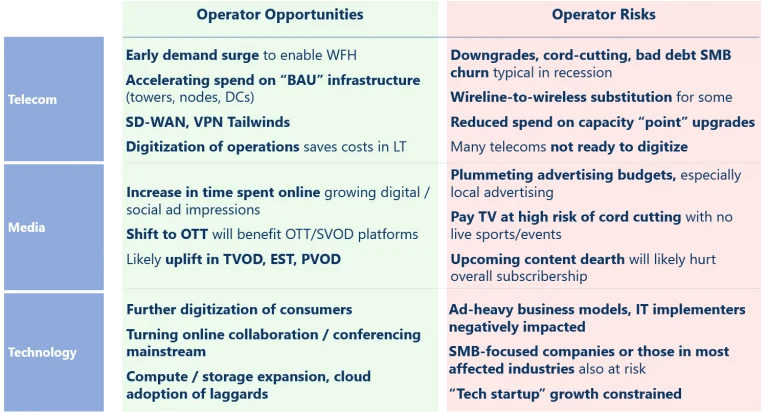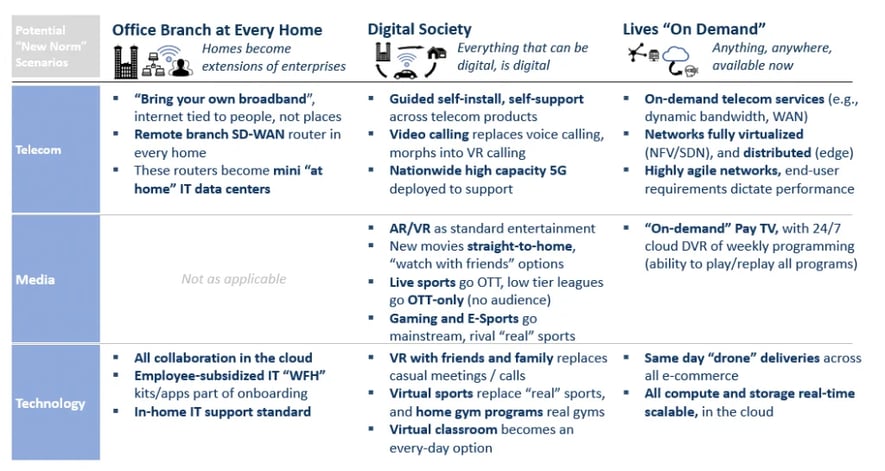NEWS & EVENTS
Covid-19: Navigating the new landscape for Telecom, Media, & Tech
COVID-19 has spread rapidly across the globe, reaching nearly every nation and costing tens of thousands of lives so far. While protecting public health is the clear priority in this pandemic, there has already been an unprecedented impact on the global economy with massive job losses and plunging stock market indexes.
The economic fallout will not spare Telecommunications, Media, and Technology (TMT), the sectors Altman Vilandrie & Company covers. However, these sectors outperformed the overall economy during the Great Recession of 2008-9. What’s more, the central role TMT sectors play in our lives, particularly during the current period of social distancing, signals a better response today than to the last economic downturn. While no one has a crystal ball – and we have many months and perhaps years before we understand the true effects of this global pandemic – trends are emerging that provide insight as to how specific segments of TMT will fare over the short and longer term.
There are some obvious trends, like streaming providers experiencing binging surges and the widespread embrace of video conferencing by both businesses and families, to less obvious ones, like the associated strain of this copious consumer consumption on internet and mobile infrastructure.
Altman Vilandrie & Company clients have asked us over the last couple of weeks for our views on the near- and long-term impacts of this crisis. In this article we have formalized our responses and views to share with a broader audience. We tapped experts from across our firm on what they are seeing in the TMT marketplace and analyzed available data to create a clearer picture of what’s happening and how our clients can weather these severe economic conditions – and also contribute to the COVID-19 response. While this analysis is not exhaustive, it provides a snapshot of our current state and shows us some potential paths forward into a new landscape shaped by COVID-19.
Social distancing bringing us together online, surging consumption – but not for all TMT areas
By now, nearly everyone is familiar with the term “social distancing” and the related public health recommendations for “lockdowns” and “quarantines” that have most Americans cloistered in their homes for much or all of the day. This home confinement has driven up demand for online media content, while at the same time prevented new, more discretionary, IT and telecom projects from moving forward.
Echoes of 2008: How TMT fared in the Great Recession

The impact of the last economic downturn, the Great Recession of 2008, on TMT was significant, but these sectors fared better and were able to rebound quicker than other industries. Tech and telecom were able to maintain positive – if low – economic output during the height of the downturn (2008-9), and media and telecom were able to bounce back to pre-recession output levels by 2014.

Given the complexity and diversity of TMT, it is no surprise that in the last global economic shock certain segments outperformed others. Computer and electronic equipment makers saw the bottom fall out of the market as consumers and business retreated from large purchases, while print media and advertising, already struggling to address the rise of digital publishing, were pushed to the brink. On the telecom side, providers reliant on small to medium sized businesses (SMB) were hardest hit.
Still, there were success stories. America’s insatiable appetite for smartphones kept mobile hardware makers and wireless networks humming. Broadcast and digital media outlets benefitted from consumers fleeing print, and security software providers grew even in 2009.
TMT More Resilient, Responsive than in 2008
How are things different for TMT today, amid a global pandemic and an increasingly physically isolated public? First, it’s important to recognize the economic damage COVID-19 will inflict on certain industries, including travel/hospitality and retail. Specifically, this economic downturn has already inflicted financial hardship on millions of Americans, from “gig workers,” to restaurant employees, to childcare providers, and many others. Many small businesses are not expected to reopen after the shutdown. While the federal government just approved a $2 trillion economic recovery package, most economists expect there is much more to be done to help the country regain its financial footing.
The outlook for TMT, while still uncertain, is more positive than the overall economy. Compared to 2008, the fundamentals, particularly for telecom and tech, are much stronger. As a result, we expect tech and telecom will outperform both the overall economy and fare better than they did in 2008-9. The media outlook is murkier. Clearly, homebound families are dependent on an incredibly diverse menu of video content providers in an all-you-can-watch buffet. Since most providers are not generating more revenue even as consumers watch more content, they need to be satisfied with retaining subscribers and treat subscriber gains, if lasting, as upside. But what happens when the content runs out? In a protracted shutdown, the lack of live sports could hurt networks and pay TV providers. In addition, Hollywood has stopped production of new shows and movies, drying up a pipeline of new content to engage viewers.

Risks, opportunities for TMT
Smart TMT players with the scale and strength to respond will assess the risks in their sectors due to COVID-19 and adapt to succeed in this new reality. This will require different strategies across the sectors and even within each sector. For example, telecom network providers may have success with migrating more customers to SD-WAN, which doesn’t require on-site server configuration and has the potential to significantly improve the work from home experience by replicating “office quality” networking capabilities. But those providers who have been dependent on SMB customers may find a new reality with a reduced customer base and fewer companies able to invest in new IT projects.

Do the Right Thing > Stabilize Your Business > Emerge Stronger over the Long Run
Since this economic challenge was wrought by a deadly health crisis, there is more at stake here than profits and projections. Businesses have a responsibility to respond to the COVID-19 outbreak to protect our employees, customers, and communities. TMT firms, which thrive on innovating and have a unique connection to the everyday lives of Americans, are very well positioned to help in the response to this outbreak. While specific strategies depend on rigorous analysis of markets and capabilities, below are some general ways TMT firms can help address today’s COVID challenges and become more competitive over the long term.

COVID-19 Will Change the Way We Live and Work Forever
Without question, COVID-19 will change our society, including the way we live, work, communicate, interact, and entertain ourselves. Not every adaptation we have made during this remarkable period in history will stick once we get back to “normal,” but some adaptations we have made or will make will become permanent.
Many of us have created home offices that, at the very least, allow us to create a reasonable facsimile of our in-office experience. As social distancing continues, employers will provide more remote tools to increase productivity and workers will become more comfortable working from home – leading more companies to question the need for traditional office space in the future. The lockdown has also revealed that, if you have the financial means, you can access nearly any form of entertainment or commerce instantly through digital channels, an expectation that will only grow as immersive virtual reality experiences become more common in American households. Our experts have identified these and other potential scenarios of this new future, which are compiled below.

Look for deeper assessments of the impacts of this crisis on the TMT space from Altman Vilandrie & Company over the coming days and weeks.